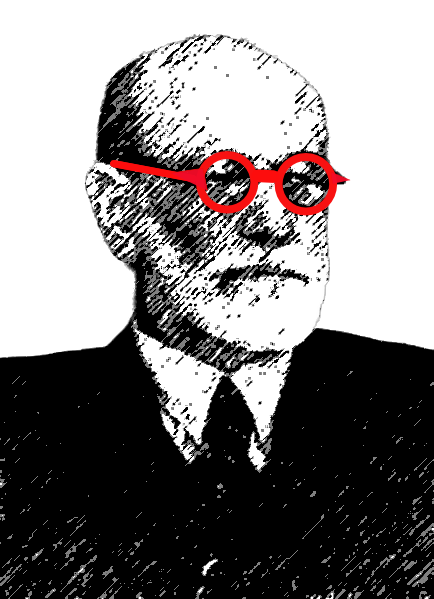
I’d be hard pressed to guess how many pages have been devoted to the life and times of Sigmund Freud. Hundreds of thousands? Millions? I’ve contributed more than a hundred here alone. But there are still a few things about the father of psychoanalysis that most people don’t know, 75 years after his death, details about his everyday life that get lost in the scholarship.
To mark the anniversary of Freud’s death, September 23, 1939, I’ll share a sampling of them.
Note: Most of the details about Freud’s dining habits come from the book Dining With Sigmund Freud: Lifestyle, Hospitality and Eating Habits of the Founder of Psychoanalysis, by Katja Behling-Fischer, which was translated for me from the German.
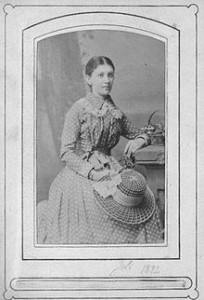
1. Freud put his fiancé, Martha Bernays, in charge of his finances soon after they got engaged. Freud worried about money while going to medical school, and would send his bills from Vienna to Martha in Hamburg, where she lived with her family. He reported to her that he was trying to limit the number of times he dined out, and that he ate modest dinners of cheese and meat in his rooms in order to economize. He gave Martha an account of the amount of chocolate he ate, and asked her advice on whether he should drink coffee or tea.
2. Freud hated cauliflower and poultry, especially chicken. He never ate either, and had such a strong dislike of both that he avoided dining at homes where he had been served these items. He wrote to a friend that he was happy not to have landed in Bad Ischl or in Reichenau for summer vacation, writing in parentheses “Huhn und Blumenkohl” (chicken and cauliflower).
According to his son Martin, Freud would occasionally say, “One shouldn’t kill any chickens; let them live and lay eggs.”
His aversion for these food items didn’t stem from a dislike of white (or white-ish) food, however. Freud’s favorite dessert was homemade vanilla ice cream.
3. Freud was a forager–and a farm-to-table fan. All of today’s culinary trends? Freud was ahead of the curve.
During summer vacations, Freud loved to take his children to pick berries and gather mushrooms. Martha preferred her mushrooms store bought. It’s not clear whether that was because she didn’t trust Sigmund’s ability to tell the poisonous from the benign variety or whether she thought the foragers’ yield would be too small for a meal.
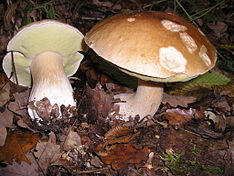
Freud loved seasonal specialities like asparagus, corn on the cob, and Italian artichokes. He had Martha forage for them at the market.
4. Freud believed eating kosher food was bad for the health–but some of it probably turned up on his table nevertheless. Martha Bernays was the granddaughter of the chief rabbi of Hamburg and grew up observing Jewish dietary laws strictly. During her extended engagement to Freud, in response to a note to him that she was feeling unwell, Sigmund urged her to break the rules of kashrut, which he believed to be detrimental to one’s health.
Martha didn’t go along with her fiancé’s suggestion while she lived at home, but deferred to Freud’s wishes after they married–or did she? Stories handed down from my family said that Frau Freud bought her meat from my great uncle Siegmund Kornmehl’s kosher butcher shop, which was just down the block (#15 Berggasse) from his main butcher shop in the Freuds’ building (#19 Berggasse). Behling-Fischer writes that Martha took care to do the daily shopping herself (often with her sister Minna) “to be certain that everything was both fresh and economical.” I suspect there might have been another reason for the personalized shopping excursions: Perhaps the two sisters didn’t trust members of the household staff, who would have been loyal to their employer, not to tell the kosher-averse Herr Professor where they bought their meat.
It is frequently noted that Martha resumed lighting Sabbath candles and returned to being kosher after Freud’s death. It’s possible that she never entirely stopped observing Jewish dietary laws during his life.
5. Anna Freud used to write poems to her father on his birthday in the persona of her dog, Wolf. Sigmund became besotted with dogs late in life when Anna Freud got her first dog, a German shepherd named Wolf, in the mid-1920s. Anna used to joke that her father loved her dogs more than he loved her–and, thanks to her father, we know that “just kidding” doesn’t cut it.
Here’s an example of one of the poems that Anna would attach to Wolf’s collar before sending him in to see her dad on his birthday. It’s taken from the introduction to Topsy: The Story of a Golden-Haired Chow, which Freud and Anna translated while waiting to leave Vienna in 1938:
On account of the coming of much of the clan
A house ban
Now ‘gainst his normal demeanor and noise
Silently poised.
His love for the friendly as edible
As with sucked-up thermometers, immeasurable.
Thus kept from the banquet so nourishing and fair
He gets from the table scraps none of his share.
Unwavering true: ‘ spite of fleeting pleasure’s bite,
He withdraws, quite dog-like.
6. Freud fed his dogs from his own plate. Freud’s fondness for Anna’s dog led him to acquire his own canine companions, a series of chows. Yofi, the one Freud lived with longest, not only sat in on his master’s psychoanalytic sessions and served as timekeeper; he was also present at family meals and would lie at Freud’s feet. Freud fed Yofi from the table and from time to time would even put his plate on the floor for the dog. Freud made the rules, however–or liked to think he did. Yofi was not allowed to beg.
Freud’s granddaughter Sophie recalls that Freud’s dog got the best ham in the family. Yofi (which means lovely in Hebrew) probably got the best kosher beef too.
7. Freud’s farsightedness was literal as well as figurative.
In a June 14th, 2013 post titled, Framing Sigmund: The Mystery of Freud’s Glasses, I mused about the fact that I couldn’t find the prescription of Freud’s iconic glasses. I wrote to both Freud museums, in London and in Vienna, and was surprised to learn no one had every tested the lenses, given how unobtrusive that process is.
But a few months after my original inquiry, I got an answer from Bryony Davis, Assistant Curator at the Freud Museum in London:
I thought you might like to know that this afternoon a local optician came to the museum to have a look at Freud’s wire framed glasses and to test the lenses for his prescription. The results were R: +5.00 -0.75 x 20; L: +7.25 -1.25 x 68. Not knowing much about optical prescriptions this meant little to me, but the optician said it is a very strong lens. The glasses are fairly fragile, and up close are incredibly small, but the procedure was quick and simple – and now I can provide a long-belated answer to your question! I hope you find it interesting.
I did find it interesting, but needed help with interpretation, not being schooled in optics either. From WebMd’s How to Read Your Eyeglass Prescription:
In general, the further away from zero the number on your prescription, the worse your eyesight and the more vision correction you need. A plus sign in front of the number means you are farsighted and a minus sign means you are nearsighted…
For example, if your prescription says -1.00, you have one diopter of nearsightedness. This is a fairly mild amount of nearsightedness. If you are -4.25, that means you have 4 and 1/4 diopters of nearsightedness. This is more nearsighted than -1.00, and requires stronger (thicker) lenses. Similarly, +1.00 would be a small amount of farsightedness and +5 would be more.
So Freud was very farsighted in his left eye, +7.25 diopters, in particular.
The other numbers refer to Freud’s astigmatism. I have tried to figure out whether Freud was very or a little astigmatic but I have astigmatism myself, and poring over the data gave me a headache. I welcome any comments on that issue–and all the others, of course.
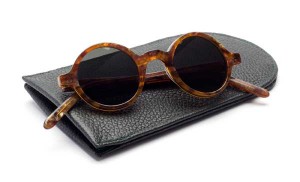

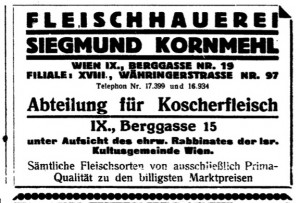
Great reading as usual Edie. Thanks for the info and the entertainment. 🙂
Thanks for coming by, Frankie — after I guilted you (and everyone else on Facebook) into it!
What an interesting post, Edie! My father would get quite a kick out of Freud’s abhorrence of chicken – he feels the same way about it. And the glasses, eyesight ….trying to even understand astigmatism gives me a headache, I feel for you!
Thanks, Kim! It’s hard for me to understand disliking chicken — but then again I know people who hate bananas, which seems really irrational.
I LOVE that you got his prescription for his glasses. What a fantastic detail to ask for. The people at the Freud museum are a right lovely bunch. Still a massive fan of the blog! Keep up the great work!
Hey, Tavis, I’ve missed seeing you here! Thanks for coming by. I was thrilled to get the glasses prescription, and couldn’t believe no one had thought to test the lenses before this past year.
One wonders what Dr. Freud would have made of a patient who came to him with such a strong food aversion. Or is sometimes a chicken just a chicken?
BTW, I’m reading Cat Warren’s What the Dog Knows and absolutely love it. I described the writing as having that informative and entertaining vibe that I usually get from Mary Roach or Edie Jarolim. The person knew just what I meant. 🙂
I thought about that, Pamela, i.e., if he thought his own food issues were a bit odd. Maybe the Chicken Chronicles were part of the self-analyzing journals you destroyed.
Well, now I have to find the only other person in the world who thinks I write like Mary Roach! Seriously, I just looked What the Dog Knows up and it looks really fascinating. Thanks for the suggestion (and, as always, the support. I’m terrible at compliments.)
Very interesting about his glasses. We saw Melville’s glasses at the little Melville museum room in Pittsfield, Mass. (Ed, my husband, is a Melville guy.) There was something so touching and intimate about seeing them.
So…did you find out Melville’s prescription?
The refusal to consume cauliflower is truly Freudian. Not only are they called ‘heads,’ but they look like brains. He’d be consuming his livelihood.
Or maybe he couldn’t afford to be gassy while in close quarters during his sessions…
Wonderful post with such interesting Freud trivia. The eyeglass inquiry was a great read.
Hi Edie,
Enjoyed this post, especially the part about Anna’s poetry. How endearing! One of my all time favorite books is “Jokes and their Relationship to the Unconscious”, much of which remains unprecedented.
If you’re interested, I’ve written a novel with perhaps the most hilarious scene ever written based on Freud’s penis envy theory. The novel can be found on my blog, “Time Measured by Touch.”
Thanks,
Jeff
P.S. Everything is just fine between me and my mother!
Thanks for stopping by, Jeff. I will definitely check out your novel.
And I’m glad all’s well between you and your mother!
Best,
Edie
Bonjour Edie,
Wow! What a great read.
I LOVE your blog.
Best regards,
Selima
Thank you so much!
Inspired by this post I’ve finally come up with an article about Freud and asparagus, the phallic food: https://schibboleth.com/freuds-asparagus-the-vegan-wiener-white-french-with-hazelnuts-and-light-vinaigrette-or-green-italian-with-olives-and-lime-recipevideo-voluptuousvegan-feministfood/
I, in turn, am inspired by the recipes to come back to Vienna and have you prepare them for me! I especially like the hazelnuts and vinaigrette combo!
I love this blog. Care to check out my novel about Freud (and many other matters)?
Here’s the link:
https://dailstrug.files.wordpress.com/2016/03/significant-moments1.pdf
The last two decades have saddened me a great deal because Freud has been villified so that some modern psychoanalysts’ could make a case for their own theories of psychoanalysis. Also, Managed Care Insurance Companies have used cbt to shorten treatment this increasing there profits, as well as other things. In 42 years of private practice and 35 years of Psychoanalytically informed psychotherapy, I found absolutely nothing in his works that was not true of me. Freud changed my life, along with the Psychologist I worked with.
Very interesting. As an ophthalmologist I can tell you that he had hypermetropic astigmatism and a reasonably high one at that. This means that he would have required his glasses for pretty much everything, but absolutely for reading, for most of his life. In fact, without them, he would be pretty helpless! Thanks for inquiring and kudos for the curator for checking!
Thanks very much for your addition to this discussion!
Such a good question about his glasses! But of course I enjoyed reading about his fondness for his dogs even more.
Thanks, Kate. And yes, of course you were interested in the dogs. There’s plenty more information about Freud’s puppy love to come!
I studied OptoOffice work in California and Counseling. Yofi.